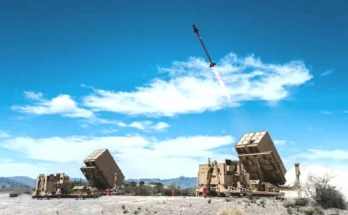by Stuart Slade, Senior Naval Systems Analyst, Forecast International.
Ten sailors are missing and five were injured after DDG-56 USS John S. McCain was involved in a collision with the Alnic MC, a 600-foot oil tanker. The collision took place off Singapore about 5.24 a.m. local time on August 21. Five sailors were injured in the collision, and 10 are missing. The McCain suffered “significant damage to the hull” after a hole was torn in the warship beneath the waterline. It led to flooding of crew accommodation and a communications rooms and, most critically, caused flooding in a shaft tunnel.
The shaft tunnel is the space in the ship through which a shaft from the gas turbines runs aft to the propellers. This tunnel acts as a flooding path by which floodwater can spread throughout the stern of the ship. Therefore, preventing additional water ingress to the shaft tunnel is a survival-critical function of damage control.
The U.S. Navy said four of the injured sailors were medically evacuated by Singapore Armed Forces helicopter to a hospital in Singapore with non-life threatening injuries. The fifth sailor did not need further medical attention. A multinational search-and-rescue effort involving Singapore, Malaysia, Indonesia and the U.S. is underway to locate the missing sailors, and there were early reports on August 22 that the remains of the some of the missing sailors had been found. The ship has limited propulsion and electrical power but good communications as she heads back into port. The LHA-6 USS America is currently steaming toward McCain to stand by the damaged destroyer.
This collision comes two months after the USS Fitzgerald suffered a collision with the container ship Crystal in which seven sailors died. An inquiry, which published its results a few days ago, pinned the blame for that collision on faulty watchkeeping practices, inadequate training, and improper supervision of the bridge crew by the command triumvirate. However, the report was silent on exactly how a fast, agile destroyer ended up colliding with a slow clumsy merchant ship. Now that it has happened again, the question must be asked whether there is a systemic fault at play here.
Already, the finger of suspicion is pointing at the electronic charts and automated surveillance systems that are extensively used these days. They treat navigation and watchkeeping as a science, which neither is. Both are art forms built on a science, and both require extensive training, constant supervision, and exacting vigilance. The problem is that electronic charting makes everything seem easy, and the old-fashioned skills of paying close attention to the radar screen, performing maneuvering board analysis on the display screen for closest point of approach (CPA) range, and being attentive to signs of close aboard contacts all too often are simply not practiced. When that happens on a bridge, where over-reliance on electronics results in lookouts who are inattentive and an inexperienced officer on deck (OOD) who doesn’t know what to do at the moment of extremis, the result, as we have now seen twice in as many months, can be tragic.
Another problem is that the modern sensor systems do not give raw data to the bridge crew unless it is specifically asked for. The displays give processed data that are derived as a result of specific inserted rules. If these are inappropriate, the results can be highly misleading. For example, navigation radars can be set to give a variety of ranges, with the level of detail decreasing as range increases. Typically, these range scales are 1, 5, 10, 15 and 20 nautical miles, with the radar usually being set to 10 miles as the best general duties compromise. In at least one case in the recent past, the radar display was reset to 5 miles for a specific situation, but not reset to 10 miles. When the watch changed, the new operator didn’t realize he was looking at a 5-mile display and that a contact was twice as close as he realized. When the actual situation was discovered, it was what the Navy calls an “Oh dear moment,” or words to that effect.
The statement used as the headline of this post was made by Adm. David Beattie, commander of the battle cruiser squadron of the Royal Navy at the Battle of Jutland in 1916. He made it after watching three of his ships explode in quick succession. He was quite right on both counts; there was something wrong with the way his ships had been designed, but the losses were actually due to faults in the operational (ammunition-handling) systems in force on board. McCain and Fitzgerald are wake-up calls indicating that a fundamental, wide-ranging review of basic navigational procedures is in order.
Please feel free to use this content with Forecast International and analyst attributions, along with a link to the article. Contact Ray Peterson at +1 (203) 426-0800 or via email at ray.peterson@forecast1.com for additional analysis.
FI’s Naval Systems Market Intelligence Services cover two distinct markets: anti-submarine warfare and warships. The Anti-Submarine Warfare Forecast provides market analysis of the sensors and weaponry used in the detection and prosecution of submarines, while the Warships product covers the full range of worldwide warship programs, including reports on key naval weapons and unmanned surface and subsurface vehicles.
For 50 years, Forecast International intelligence reports have been the aerospace and defense industry standard for accurate research, analysis, and projections. Our experienced analysts compile, evaluate, and present accurate data for decision makers. FI's market research reports offer concise analysis of individual programs and identify market opportunities. Each report includes a program overview, detailed statistics, recent developments and a competitive analysis, culminating in production forecasts spanning 10 or 15 years. Let our market intelligence reports be a key part of reducing uncertainties and mastering your specific market and its growth potential. Find out more at www.forecastinternational.com




